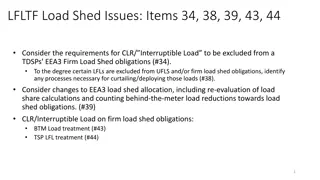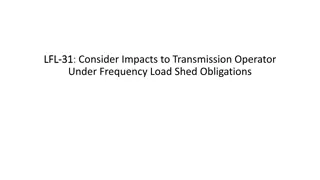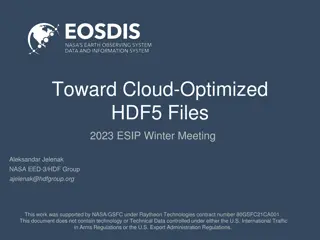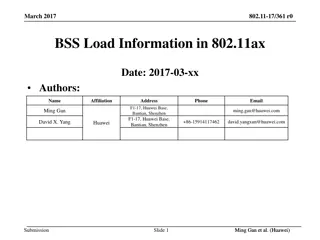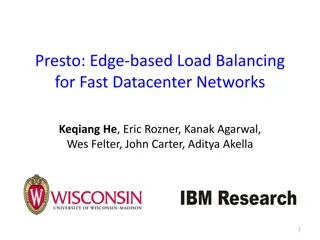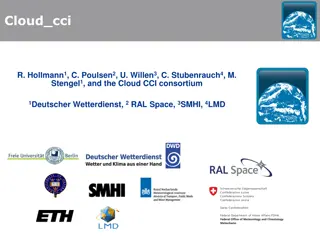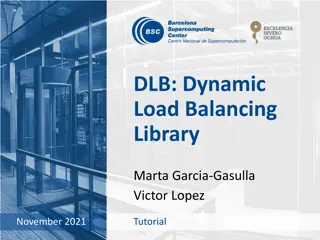Cloud Load Balancing Overview and Requirements
This content provides a detailed overview of cloud-scale load balancing, involving components like servers, hypervisors, VMs, VIPs, DIPs, and the role of load balancers in distributing workloads efficiently. It also discusses communication flows involving VIPs, DIPs, front-end VMs, back-end VMs, and the need for reliable and scalable load balancer solutions in cloud environments. The state-of-the-art cloud requirements for throughput, redundancy, and quick failover are highlighted, emphasizing the critical role of load balancing in modern cloud infrastructures.
Download Presentation

Please find below an Image/Link to download the presentation.
The content on the website is provided AS IS for your information and personal use only. It may not be sold, licensed, or shared on other websites without obtaining consent from the author.If you encounter any issues during the download, it is possible that the publisher has removed the file from their server.
You are allowed to download the files provided on this website for personal or commercial use, subject to the condition that they are used lawfully. All files are the property of their respective owners.
The content on the website is provided AS IS for your information and personal use only. It may not be sold, licensed, or shared on other websites without obtaining consent from the author.
E N D
Presentation Transcript
Ananta: Cloud Scale Load Balancing Presenter: Donghwi Kim 1
Background: Datacenter Each server has a hypervisor and VMs Each VM is assigned a Direct IP(DIP) Each service has zero or more external end-points Each service is assigned one Virtual IP (VIP) 2
Background: Datacenter Each datacenter has many services A service may work with Another service in same datacenter Another service in other datacenter A client over the internet 3
Background: Load-balancer Entrance of server pool Distribute workload to worker servers Hide server pools from client with network address translator (NAT) 4
Inbound VIP Communication payload payload payload src: Client, dst: VIP src: Client, dst: VIP src: Client, dst: VIP Internet Do destination address translation (DNAT) src: Client, dst: DIP1 src: Client, dst: DIP2 src: Client, dst: DIP3 payload payload payload VIP LB Front-end VM Front-end VM Front-end VM DIP 1 DIP 2 DIP 3 5
Outbound VIP Communication Datacenter Network payload src: VIP1, dst: VIP2 Do source address translation (SNAT) payload src: VIP1, dst: VIP2 VIP 1 VIP 2 LB LB Front-end VM Front-end VM DIP 4 Front-end VM DIP 5 Front-end VM Back-end VM src: DIP2, dst: VIP2 payload DIP 3 DIP 1 DIP 2 Service 1 Service 2 6
State of the Art A load balancer is a hardware device Expensive, slow failover, no scalability LB 7
Cloud Requirements Scale Requirement State-of-the-art ~40 Tbps throughput using 400 servers 20Gbps for $80,000 100Gbps for a single VIP Up to 20Gbps per VIP Reliability Requirement State-of-the-art N+1 redundancy 1+1 redundancy or slow failover Quick failover 8
Cloud Requirements Any service anywhere Requirement State-of-the-art Servers and LB/NAT are placed across L2 boundaries NAT supported only in the same L2 Tenant isolation Requirement State-of-the-art An overloaded or abusive tenant cannot affect other tenants Excessive SNAT from one tenant causes complete outage 9
Ananta 10
SDN SDN: Managing a flexible data plane via a centralized control plane Controller Control Plane Switch Data plane 11
Break down Load-balancer s functionality Control plane: VIP configuration Monitoring Data plane Destination/source selection address translation 12
Design Ananta Manager Source selection Not scalable (like SDN controller) Multiplexer (Mux) Destination selection Host Agent Address translation Reside in each server s hypervisor 13
Data plane 1sttier (Router) packet-level load spreading via ECMP. 2ndtier (Multiplexer) connection-level load spreading destination selection. 3rdtier (Host Agent) Stateful NAT dst: VIP1 dst: VIP1 dst: VIP2 dst: DIP3 dst: VIP2 dst: DIP1 dst: VIP1 dst: DIP2 dst: VIP1 . . . Multiplexer Multiplexer Multiplexer dst: DIP3 dst: DIP1 dst: DIP2 Host Agent Host Agent Host Agent . . . VM Switch VM Switch VM Switch . . . . . . . . . VM1 VM1 VM1 VMN VMN VMN 14
Inbound connections Host 2 s: CLI, d: VIP s: MUX, d: DIP s: CLI, d: VIP 4 s: CLI, d: DIP Router Router Router 3 MUX MUX MUX Host Agent 1 5 VM DIP 8 s: VIP, d: CLI Client 7 6 s: DIP, d: CLI 15
Outbound (SNAT) connections Map VIP:777 to DIP Map VIP:777 to DIP s: MUX, d: DIP:555 s: SVR:80, d: VIP:777 s: SVR:80, d: VIP:777 s: SVR:80, d: DIP:555 Port?? Server s: VIP:777, d: SVR:80 s: DIP:555, d: SVR:80 16
Reducing Load of AnantaManager Optimization Batching: Allocate 8 ports instead of one Pre-allocation: 160 ports per VM Demand prediction: Consider recent request history Less than 1% of outbound connections ever hit Ananta Manager SNAT request latency is reduced 17
VIP traffic in a datacenter Large portion of traffic via load-balancer is intra-DC Total Traffic VIP Traffic Internet 14% VIP Traffic 44% Inter-DC 16% DIP Traffic 56% Intra-DC 70% 18
Step 1: Forward Traffic Host VIP1 VM DIP1 MUX MUX MUX1 Host Agent Data Packets 1 Host VIP2 VM DIP2 2 MUX MUX MUX2 Host Agent Destination 19
Step 2: Return Traffic Host VIP1 VM DIP1 4 MUX MUX MUX1 Host Agent Data Packets 1 3 Host VIP2 VM DIP2 2 MUX MUX MUX2 Host Agent Destination 20
Step 3: Redirect Messages Host VIP1 VM DIP1 MUX MUX MUX1 Host Agent Redirect Packets 6 7 5 Host VIP2 VM DIP2 MUX MUX MUX2 Host Agent Destination 21
Step 4: Direct Connection Host VIP1 VM DIP1 MUX MUX MUX1 Host Agent Redirect Packets Data Packets 8 Host VIP2 VM DIP2 MUX MUX MUX2 Host Agent Destination 22
SNAT Fairness Ananta Manager is not scalable More VMs, more resources DIP 4 6 5 DIP 1 DIP 2 DIP 3 Pending SNAT Reques ts per DIP. At most on e per DIP. 1 2 3 4 3 Pending SNAT Reques ts per VIP. VIP 2 VIP 1 2 1 4 Global queue. Round- robin dequeue from V IP queues. Processed by thread pool. SNAT proces sing queue 1 3 2 4 23
Packet Rate Fairness Each Mux keeps track of its top-talkers (top-talker: VIPs with the highest rate of packets) When packet drop happens, Ananta Manager withdraws the topmost top-talker from all Muxes 24
Reliability When Ananta Manager fails Paxos provides fault-tolerance by replication Typically 5 replicas When Mux fails 1sttier routers detect failure by BGP The routers stop sending traffic to that Mux. 25
Evaluation 26
Impact of Fastpath Experiment: One 20 VM tenant as the server Two 10 VM tenants a clients Each VM setup 10 connections, upload 1MB data 60 No Fastpath 55 40 % CPU 20 13 10 2 0 Host Mux 27
Ananta Managers SNAT latency Ananta manager s port allocation latency over 24 hour observation 28
SNAT Fairness Normal users (N) make 150 outbound connections per minute A heavy user (H) keep increases outbound connection rate Observe SYN retransmit and SNAT latency Normal users are not affected by a heavy user 29
Overall Availability Average availability over a month: 99.95% 30
Summary How Ananta meet cloud requirements Requirement Description Scale Mux: ECMP Host agent: Scale-out naturally Reliability Ananta manager: Paxos Mux: BGP Any service anywhere Ananta is on layer 4 (Transport layer) Tenant isolation SNAT fairness Packet rate fairness 31
Discussion Ananta may lose some connections When it recovers from MUX failure Because there is no way to copy MUX s internal state. TCP flows 1sttier Router MUX 5-tuple DIP DIP1 DIP2 ??? MUX (NEW) 32 5-tuple DIP
Discussion Detection of MUX failure takes at most 30 seconds (BGP hold timer). Why don t we use additional health monitoring? Fastpath does not preserve the order of packets. Passing through a software component, MUX, may increase the latency of connection establishment.* (Fastpath does not relieve this.) Scale of evaluation is too small. (e.g. Bandwidth of 2.5Gbps, not Tbps). Another paper insists that Ananta requires 8,000 MUXes to cover mid-size datacenter.* *DUET: Cloud Scale Load Balancing with Hardware and Software, SIGCOMM 14 33
Thanks ! Any Questions ? 34
Backup: ECMP Equal-Cost Multi-Path Routing Hash packet header and choose one of equal-cost paths 36




